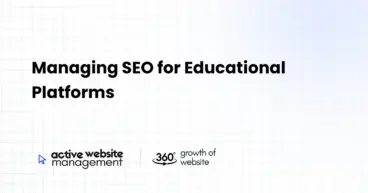January 8, 2025
12 min read
Okay, you’ve got a fantastic retail store. Shelves stacked high, products flying off the racks – or maybe you’re just starting and dreaming of that. But if your website isn’t showing up when people search online, it’s like having a hidden gem in a dark alley. You need to be found where your customers are looking: online. This means diving deep into retail website SEO or, as some might call it, store website optimization. Let’s break down how to make your virtual storefront shine and attract a steady stream of eager buyers.
Understanding the Foundation of Retail Website SEO
Before we dive into tactics, let’s grasp the core principles. SEO (Search Engine Optimization) for retail isn’t just about tricking Google; it’s about making your website user-friendly and relevant, both for humans and search engines. When we talk about local business SEO, for brick-and-mortar stores it adds the extra dimension of connecting you with customers in your geographic area. It’s a multi-faceted approach.
Why is SEO Crucial for Retail Stores?
Imagine someone in your town needs a specific type of running shoe. They’re not going to leaf through the Yellow Pages (remember those?). They’re going to Google it. If your store’s website isn’t optimized, it won’t appear in those search results. You’re essentially invisible.
Here’s why SEO is indispensable for your retail store:
- Increased Visibility: Higher search rankings mean more people see your website. The better your SEO, the more often you show up when customers search for products you offer.
- Targeted Traffic: SEO brings in users actively searching for what you sell. It’s not random traffic; these people are already interested in making a purchase.
- Cost-Effective Marketing: Compared to paid advertising, organic SEO offers a more sustainable, long-term solution for attracting customers.
- Builds Brand Authority: A website that ranks highly on Google is perceived as trustworthy and reliable, strengthening your brand.
- Competitive Advantage: If your competitors are optimizing for SEO and you’re not, you’re losing potential customers to them daily. Local business SEO especially, can help you beat national brands in your local market.
- 24/7 Marketing: Your website, when optimized, acts as a tireless salesperson, working for you even when you’re closed.
The Two Pillars of SEO: On-Page and Off-Page
Think of your website’s SEO as a house: it needs a solid foundation (on-page) and a strong external support system (off-page).
- On-Page SEO: This involves everything you can control directly on your website. This includes website content, structure, page speed, keyword usage, and user experience. It’s about optimizing individual pages on your site. This is your starting point for store website optimization.
- Off-Page SEO: This involves actions taken outside your website to build its authority and reputation. This includes earning backlinks from other reputable sites, social media engagement, and online mentions. It’s about getting other websites to vouch for yours, strengthening your overall presence.
Don’t Just Maintain Your Website—
Grow It using Active Website Management! Don't Wait for Growth—Accelerate It with Active Website Management
On-Page SEO: Optimizing Your Digital Storefront
This is where you take control. Your website is your digital storefront, and just like a physical store, it needs to be well-organized, attractive, and easy to navigate.
Keyword Research: Finding What Your Customers are Searching
Keywords are the terms people use when searching for products. Effective retail website SEO begins with understanding these keywords.
- Start with brainstorming: Think about the products you sell. What words would you use to describe them? Don’t just focus on generic terms like “shoes,” think about specifics like “men’s waterproof running shoes.”
- Use Keyword Research Tools: Tools like Google Keyword Planner, SEMrush, or Ahrefs will help you discover search volumes for different keywords and identify long-tail keywords (longer, more specific phrases). For example, instead of “coffee,” you might target “organic fair-trade dark roast coffee beans.”
- Analyze Competitors: See what keywords your competitors are targeting. What products do they promote, and what keywords do they use in their website content?
- Location, Location, Location: Don’t forget about the importance of local keywords like “[your city] bike shop”, or “[your neighborhood] shoe store”. Incorporate these into your site content for best results with local business SEO.
Website Content: Engage and Inform
Your website content needs to be both engaging and informative, providing valuable information to potential customers while incorporating your carefully researched keywords.
- Product Descriptions: Avoid generic manufacturer descriptions. Write unique, detailed descriptions that highlight key features, benefits, and use cases. Focus on how the product solves a customer’s problem.
- Category Pages: These pages need to be more than just a list of products. Include descriptive text that explains the category, its benefits, and helps customers understand the different options available.
- Blog Content: Create a blog to attract customers by sharing helpful content related to your products. For example, a clothing store could write articles on “how to style a denim jacket” or “the best outfits for summer travel.” This helps establish expertise and adds relevant keywords. Make sure the blog content has clear calls to action related to your product or service.
- Use Keywords Naturally: Don’t stuff keywords unnaturally into your content. Use them organically throughout your text. Focus on readability first, then keyword optimization.
Website Structure: Creating a User-Friendly Experience
A website structure that is easy for users and search engines to navigate is crucial.
- Clear Navigation: Make it easy for users to find what they’re looking for. Use a logical menu structure and clear category labels.
- Simple URL Structure: Use short, descriptive URLs that include keywords. For example,
yourstore.com/mens-running-shoes is better than yourstore.com/product?id=123. - Internal Linking: Link to relevant pages within your website to help users (and search engines) discover more content. For example, link from a blog post about running shoes to your men’s running shoe category page.
- Mobile-Friendliness: In today’s world, most users browse on their phones. Ensure your website is responsive and looks great on any device. Use Google’s mobile-friendly test tool to ensure your site is optimized.
Technical SEO: The Behind-the-Scenes Details
While less visible to users, technical SEO is crucial for search engine crawlers.
- Page Speed: A slow-loading website will frustrate users and hurt your rankings. Optimize images, use caching, and consider a content delivery network (CDN) to improve loading times.
- XML Sitemap: Submit an XML sitemap to search engines to help them find and index all of your website’s pages.
- Robots.txt: Use a
robots.txt file to tell search engines which pages they should not crawl. This helps manage crawl budget and avoid indexing duplicate content. - HTTPS Security: Make sure your website is secured with HTTPS, which protects user data and is favored by search engines. This is essential for trust with users and a must for ranking.
- Schema Markup: Add schema markup (structured data) to your pages. This provides search engines with more context about your content and can improve search results visibility with rich snippets (star ratings, product prices).
Local SEO Optimization for Brick-and-Mortar Businesses
If you have a physical store, local business SEO is non-negotiable.
- Google My Business Profile: Create and optimize a Google My Business profile. Include accurate store information (address, phone number, hours), photos, and customer reviews.
- Local Citations: Ensure your store’s name, address, and phone number (NAP) are consistent across all online directories and websites.
- Local Keywords: Use local keywords throughout your website content and Google My Business profile (e.g., “best bakery in [your city]”).
- Customer Reviews: Encourage customers to leave reviews on Google, Yelp, and other relevant platforms. Positive reviews significantly improve your local rankings.
Off-Page SEO: Building Your Online Reputation
Now, we move outside of your website. Think of this as building community and gaining trust.
Link Building: Earning Trust From Other Websites
Backlinks (links from other websites to yours) are a crucial ranking factor. Search engines interpret backlinks as votes of confidence in your site.
- Guest Blogging: Write guest posts for related websites in your industry. Include a link back to your website in the author bio or within the content.
- Broken Link Building: Find broken links on other websites and suggest your site as a replacement.
- Community Engagement: Participate in online communities and forums related to your industry and link back to your website when appropriate.
- Local Partnerships: Collaborate with other local businesses or organizations and ask them to link to your website.
- Focus on Quality: Prioritize links from reputable, high-authority websites. Links from spammy or irrelevant websites can hurt your rankings.
Social media is a powerful tool for boosting brand awareness and generating traffic to your website.
- Active Presence: Maintain an active presence on social media platforms relevant to your target audience.
- Share Valuable Content: Share blog posts, product updates, and other engaging content.
- Engage With Your Audience: Respond to comments and messages promptly. Build relationships with your followers.
- Social Sharing Buttons: Make it easy for users to share your content on social media by adding social sharing buttons to your website.
Don't Wait for Growth—Accelerate It with
Active Website Management Don't Wait for Growth—Accelerate It with Active Website Management
Online Mentions and Brand Building
Don’t underestimate the power of simply being talked about.
- Press Releases: If you have exciting news, issue a press release to increase brand visibility and earn valuable backlinks.
- Industry Influencers: Partner with industry influencers to promote your products.
- Customer Testimonials: Share customer testimonials on your website to build trust and credibility.
- Online Reputation Management: Monitor online mentions of your brand and address any negative feedback promptly.
Tracking and Measuring Your SEO Efforts
SEO is not a one-time task. It’s an ongoing process. You need to track your progress and make adjustments as needed.
- Google Analytics: Track key metrics such as organic traffic, bounce rate, and conversion rate.
- Google Search Console: Monitor your site’s performance in Google search results. Identify and fix any technical issues.
- Keyword Rankings: Track your website’s ranking for your target keywords.
- Competitor Analysis: Regularly monitor your competitors’ SEO strategies to identify opportunities for improvement.
Active Website Management: Your Partner in SEO Success
All of this can sound overwhelming, right? That’s where a service like Active Website Management comes in. You’ve got a business to run; you need to be dealing with customers, employees, and suppliers. Let a team of experts take the burden of store website optimization off your shoulders.
How Active Website Management Can Help:
- Comprehensive SEO Strategy: They can create and execute a comprehensive SEO strategy tailored to your business needs, including keyword research, on-page optimization, and off-page promotion.
- Technical SEO Expertise: They’ll take care of the technical aspects of SEO, ensuring your website is fast, mobile-friendly, and search engine-friendly.
- Content Creation: They can help you create high-quality, engaging content that attracts and converts customers.
- Link Building: They’ll work to build high-quality backlinks to your website, improving your search engine rankings.
- Local SEO Optimization: They can help you optimize your Google My Business profile and other local listings, ensuring you’re easily found by customers in your area.
- Regular Reporting and Analysis: They’ll provide you with regular reports on your SEO performance, allowing you to track your progress and make data-driven decisions.
- Ongoing Support: They provide continuous monitoring and support, adapting to changes in the SEO landscape and ensuring your website is always performing at its best.
Trying to handle SEO on your own while running a business can spread you too thin. Partnering with experts allows you to focus on what you do best: running your retail store, while they focus on making sure the people who need your products and services can find you online. Local business SEO is a specialty, and it’s crucial to get it right to stay competitive.
Conclusion: Your Journey to Retail Website SEO Success
Improving retail website SEO takes time and effort, but the rewards are well worth it. By optimizing your website, you can attract more customers, increase your brand visibility, and ultimately, grow your business. It’s about being deliberate, consistent, and adaptable.
Here’s a quick recap of the key steps:
- Understand the Importance of SEO: It’s not an option; it’s an essential element of modern retail marketing.
- Conduct Thorough Keyword Research: Know what terms your customers are using to find you.
- Optimize Your Website Content: Focus on providing value while incorporating relevant keywords.
- Ensure a User-Friendly Website Structure: Make it easy for users to find what they need.
- Optimize Technical SEO Elements: Get the behind-the-scenes details right.
- Maximize Local SEO Visibility: If you have a brick-and-mortar store, get seen locally.
- Build High-Quality Backlinks: Build authority with quality links from other websites.
- Engage on Social Media: Connect with your customers where they are.
- Track Your Progress and Adapt: Regularly analyze your data and improve.
- Consider Professional Help: Don’t be afraid to outsource to experts who understand store website optimization.
Don’t treat SEO like a project you can tick off. It’s a journey. Your journey to higher search rankings, increased online visibility, and a thriving retail business starts now. Whether you embark on this journey yourself or partner with someone like Active Website Management, the important thing is to start. Your customers are waiting to find you. Make sure they can.







